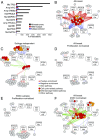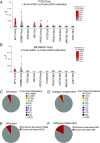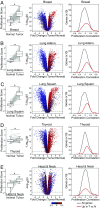Identification of cancer genes that are independent of dominant proliferation and lineage programs
- PMID: 29229826
- PMCID: PMC5748209
- DOI: 10.1073/pnas.1714877115
Identification of cancer genes that are independent of dominant proliferation and lineage programs
Abstract
Large, multidimensional cancer datasets provide a resource that can be mined to identify candidate therapeutic targets for specific subgroups of tumors. Here, we analyzed human breast cancer data to identify transcriptional programs associated with tumors bearing specific genetic driver alterations. Using an unbiased approach, we identified thousands of genes whose expression was enriched in tumors with specific genetic alterations. However, expression of the vast majority of these genes was not enriched if associations were analyzed within individual breast tumor molecular subtypes, across multiple tumor types, or after gene expression was normalized to account for differences in proliferation or tumor lineage. Together with linear modeling results, these findings suggest that most transcriptional programs associated with specific genetic alterations in oncogenes and tumor suppressors are highly context-dependent and are predominantly linked to differences in proliferation programs between distinct breast cancer subtypes. We demonstrate that such proliferation-dependent gene expression dominates tumor transcriptional programs relative to matched normal tissues. However, we also identified a relatively small group of cancer-associated genes that are both proliferation- and lineage-independent. A subset of these genes are attractive candidate targets for combination therapy because they are essential in breast cancer cell lines, druggable, enriched in stem-like breast cancer cells, and resistant to chemotherapy-induced down-regulation.
Keywords: bioinformatics; breast cancer; gene expression; oncogene; tumor biology.
Copyright © 2017 the Author(s). Published by PNAS.
Conflict of interest statement
The authors declare no conflict of interest.
Figures




References
Publication types
MeSH terms
LinkOut - more resources
Full Text Sources
Other Literature Sources
Medical

